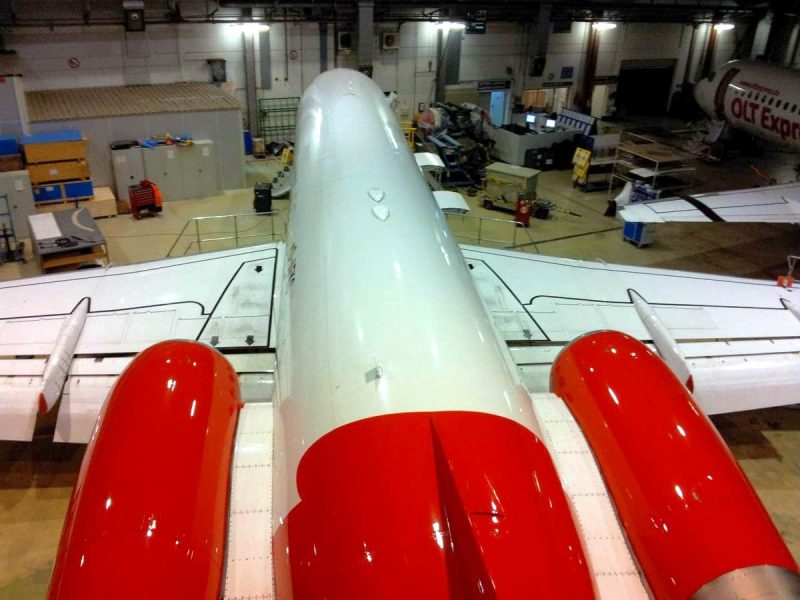Colloquially, many people like to talk about jets or jet planes. However, there are two different drive options that differ significantly from a technical point of view. While turbojets are now used more in the military sector, turbofans have long been established in civil jet aircraft. But where exactly are the differences? And what about the water injection?
Both turbojet and turbofan engines are types of aircraft engines powered by the combustion of fuel and air. However, the main difference between them lies in the way they draw in air and how they generate thrust.
A turbojet engine draws air directly into the engine and highly compresses it. The compressed airflow is then combusted with the injected fuel in a combustion chamber, and the resulting thrust creates the aircraft's propulsion. Turbojets are best suited for military jets and high-speed aircraft due to their high speed and high power.
The first aircraft to use turbojet engines was the German Messerschmitt Me 262, which first flew in 1941. The Me 262 was a fighter aircraft used by the German Luftwaffe during World War II. It was developed by Hans von Ohain and Max Hahn in Germany and was fitted with two Junkers Jumo 004 turbojet engines. The Me 262 was able to reach speeds of around 840 km/h, which gave it a distinct advantage over propeller-driven Allied aircraft. The Me 262 is considered a groundbreaking aircraft in aviation history and paved the way for the use of turbojet engines on aircraft around the world.
Nowadays, turbojet engines are rather rare in civil aviation, since they are no longer as economical as more modern engine technologies due to their high level of noise pollution and high fuel consumption. However, some older passenger aircraft were fitted with turbojet engines. Here are some examples:
Concorde: The supersonic passenger airliner Concorde, which operated from 1976 to 2003, was equipped with turbojet engines by Rolls-Royce.
Tupolev Tu-134: The Soviet Tupolev Tu-134 passenger jet was powered by Solovyov D-30 turbojet engines and flew from 1967 to 2019.
South Aviation Caravelle: The French passenger plane Sud Aviation Caravelle was fitted with Rolls-Royce Avon turbojet engines and flew from 1959 to 2005.
Boeing 707: The Boeing 707, a first-generation passenger airliner, was turbojet-engined by Pratt & Whitney and flew from 1958 to 1994.
It is important to note that these aircraft are no longer in production these days and have been replaced by more modern aircraft with more efficient engine technologies such as turbofans and turboprops.
The first civilian turbofan machine comes from the USSR
Turbofan engines, also known as fan turbojet engines, draw air in not only through the engine but also through an additional fan system at the front of the engine. The fan system, usually larger in diameter than the engine, accelerates the air, which creates some of the thrust. The rest of the air goes through the engine and is burned in the combustion chamber to create additional thrust. The advantage of turbofan engines is their higher efficiency and quieter operation, which is why they are widely used in civil aviation.
Overall, turbofan engines are the preferred choice in commercial aviation due to their higher efficiency and quieter operation, while turbojet engines are used in military applications due to their high speed and power.
The first aircraft to use turbofan engines was the Soviet Tupolev Tu-104, which first flew in 1955. The Tu-104 was a passenger airliner and was developed by Arkhip Lyulka and his team, who were also responsible for the Lyulka AL-7 engine, believed to be the forerunner of the modern turbofan. The Tu-104 was equipped with two Solovyov D-20P turbofan engines and could reach a speed of about 950 km/h. With its quieter operation, higher thrust and greater fuel efficiency compared to turbojet engines, the Tu-104 set new standards in aviation and laid the foundation for the development of modern turbofan engines, which are used in most civil aircraft today.
Water-injected engines? Yes, there was and is!
Turbojet water injection is a technique used in aviation to increase the performance of turbojet engines in certain situations. It is typically used on military aircraft, particularly older aircraft, to give them extra performance at high temperatures and low air densities.
The technique consists of injecting water into the airflow entering the turbojet engine. The water is taken from either a tank on the aircraft or from a source on the runway. Once the water is injected into the airflow, due to the high temperatures and low air density inside the engine, it quickly vaporizes and cools the airflow. This compresses the airflow and burns fuel more efficiently in the engine, resulting in increased power and thrust.
However, water injection is not without its drawbacks. Since the additional weight of the water increases fuel consumption, the technology does not make sense in normal flight operations. It can also reduce engine life, as the increased power can lead to higher temperatures and loads.
There is also water injection on some turbofan engines, particularly older or specialized models. The concept of water injection is similar to that of turbojets and turboprops: by injecting water into the combustion process, the power of the engine can be increased, especially at high temperatures or when there are high power requirements such as take-off or when performing climbs.
An example of a modern water-injected turbofan engine is the General Electric CF6-80E1, used on some versions of the Airbus A330. The CF6-80E1 features a water injection system called “Water Methanol Injection” or “WMi”. A mixture of water and methanol is injected into the compressor to increase engine performance and reduce exhaust gas temperature. As a result, higher thrust values and better performance can be achieved, especially at high temperatures or high altitudes.
However, it is important to note that water injection is not as prevalent in both turbojet and turbofan engines as it used to be in the past due to the improved performance of modern engine designs and materials.





 trail (for them it's free to use)
trail (for them it's free to use)